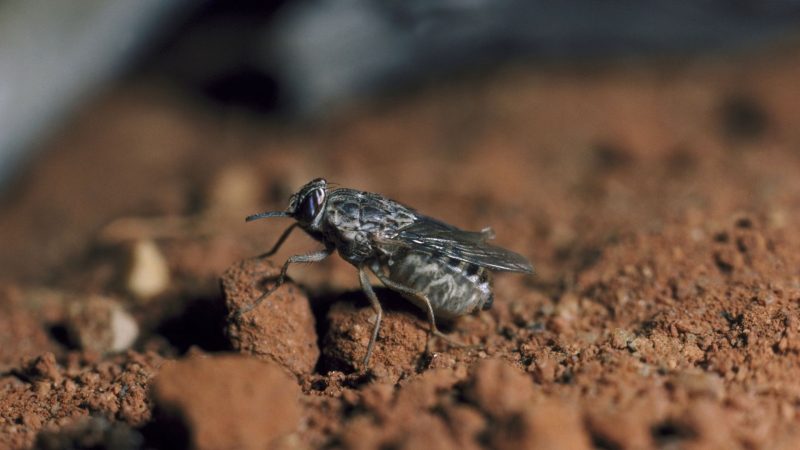Sub-Saharan Africa, a haven of picturesque sand landscapes, breath-taking waterfalls, serene rainforests, rich cultures, and traditions. But do you know that it is also the nook of a perilous fly that can cause the dreaded sleeping sickness?
What is a tsetse fly, and how dangerous are they? Tsetse flies are a group of blood-sucking creatures, similar to houseflies’ size with yellowish-brown to dark brown body color. They can be vectors of parasites that cause African Sleeping Sickness to humans, with severe symptoms and no known vaccine. This illness may result in an unconscious condition and death. It is also known to transmit a disease to cattle with serious symptoms.
Tsetse flies bite can be fatal and alarming. This article will let you probe further and explore their characteristics and traits, including the effective ways and strategies to avoid these dangerous flies’ deadly bites.
What Is a Tsetse Fly?

Tsetse flies, also known as tik-tik flies, are a group of blood-sucking creatures endemic in the vast areas of sub-Saharan Africa and are taxonomically categorized into the following classifications:
- Fusca (forest types)
- Morsitans (savanna types)
- Palpalis (riverine types)
They generally thrive in woodland areas, but when enticed to suck the blood of animal prey, they would not hesitate to go on open grasslands. Most of them are active in the morning and midday but would usually slow down when the sunset arrives.
How Does a Tsetse Fly Look?
A typical tsetse fly has a similar size to houseflies (0.2 to 0.6 inches) and has yellowish-brown to dark brown body structures. Their thoraxes are gray and often have dark lines and markings; they have three legs attached. This fly’s abdomen is filled with bands and striations, while its back is covered with wings that fold on top of each other. Their eyes are large and eagerly wide. Antennae have hairs on the uppermost area, and their mouths protrude like swords, ready to pierce anyone that may come near them.
What Does a Tsetse Fly Eat?

Tsetse flies feed on blood from different sources, although most of them crave for animal blood. However, there are flies who ingest blood from either humans or animals, depending on what is available within their sight. When they look for food, they are easily enticed by prominent blue objects, giant moving tools, and carbon dioxide.
Where Do Tsetse Flies Lay Their Eggs?
Tsetse flies lay eggs within their uterus, which then develop into a larva after a couple of days. After nine to ten days in the uterus and developing into larvae, it will be released in the sand, moist soil, or shaded places like the bottom part of fallen logs, roots, large stones, and bushes.
What Does a Tsetse Fly Do?
Part of a tsetse fly’s daily routine is the sucking of blood. This may, however, depend on certain environmental factors such as climate and temperature. Also, in the woodland setting, the male species are more inclined to bite humans while the females are more engaged in attacking animals.
What Countries Have Tsetse Fly?
The tsetse flies are only prevalent in the African region, particularly in the sub-Saharan area. This includes countries such as Angola, Burkina Faso, Cape Verde, Congo (Democratic Republic), Equatorial Guinea, Kenya, Madagascar, Mozambique, Nigeria, Rwanda, Sierra Leone, South Africa, Sudan, Tanzania, Zambia, and Zimbabwe.
What Happens if You Get Bitten by a Tsetse Fly?
Once they bite humans or animals, they can inject and harbor microorganisms into the bloodstream of their hosts. These tiny creatures can be dangerous as they can be vectors of a parasite that has the capacity to cause African Trypanosomiasis or African Sleeping Sickness, which will be discussed in the following sections. It is a disease characterized by severe symptoms, with no known vaccine as of the present time, and if not managed right away, it will result in the worst conditions.
What Is the Cure for a Tsetse Fly Bite?
When a tsetse fly bites you, it is advisable to seek medical advice. These insects have the ability to cause African Sleeping Sickness, which could be very fatal when not treated properly. If you are afflicted with this disease, a handful of treatment options are available such as intake of anti-parasitic drugs.
Furthermore, a study was presented in 2017 before the European Congress on Tropical Medicine and International Health in Antwerp, Belgium, which provided that an oral medication named Fexinidazole was effective in battling Sleeping Sickness. Based on clinical trials, the drug-treated 91% of the patients with severe symptoms and 98% of the affected individuals when mixed with another therapy regimen. It was also believed that it cured 99% of people during the early phases of the disease when a spinal tap is performed.
What Disease Is Spread by the Tsetse Fly?
When a tsetse fly makes a painful bite, it may inject Trypanosome parasites into the blood circulation. These microorganisms are the causative agents of the African Trypanosomiasis or more commonly known as the Sleeping Sickness.
There are two kinds of African Human Sleeping Sickness, namely:
Gambiense Sleeping Sickness
The Gambiense type is chronic in nature and predominant in the western and central parts of Africa. It is an illness caused by Trypanosoma brucei gambiense.
Rhodesiense Sleeping Sickness
Rhodesiense type is an acute disease and inflicts individuals mostly from East Africa. It is a disease brought by Trypanosoma brucei rhodesiense.
Once these parasites go through your bloodstream and invade your body tissues and fluids, you will feel a variety of symptoms which include the following:
- Fever
- Headache
- Severe itching
- Swollen lymph nodes
- Somnolence
- Abnormal behavior
- In worst cases, enlargement of the spleen and liver, inflammation of the blood vessels.
When this disease is not provided with proper management and intervention, the affected individual may be put in a comatose condition and, in worst cases, death.
What Disease Is Spread by Tsetse Flies to Cattle?
Tsetse flies can also bring diseases to cattle. One of which is the African Animal Trypanosomiasis, an illness brought by Trypanosoma congolense, Trypanosoma vivax, or Trypanosoma brucei. It is primarily transmitted by tsetse fly bites but can also be passed through infected body fluids. Common symptoms include fever, swelling of tissues, muscle wasting, and anemia. The bodies of the affected animals may be paralyzed, and their liver, spleen, and lymph nodes may swell.
How to Protect Yourself From Tsetse Fly?
Due to the serious health risks that these flies bring, it is very important to protect yourself from their bites. This can be done by constantly employing preventive measures when going to places where tsetse flies are abundant. The following are the efficient ways of protecting yourself from tsetse flies:
- Wearing thick clothing can be very helpful in avoiding tsetse fly bites. This can be done by donning pieces of clothes that minimize skin exposure, such as long-sleeved tops, long pants, socks, and shoes. It is also recommended to avoid wearing bright or dark-colored clothing and fabrics with metallic shades as it can entice tsetse flies to go near you.
- Tsetse flies can attack you when sleeping or resting. Thus, an important preventive measure is the use of screens or bed nets. The holes must not be too big, and they must not have any openings to prevent these insects’ entry. Also, it would be better if the bed nets had a rectangular structure, treated with permethrin every six months and inserted forcefully beneath the mattress. Sleeping or lounging in a room with an air conditioning unit can also be an excellent precautionary measure.
- Before you enter a vehicle, check and assess the areas inside for the presence of tsetse flies.
- Avoid riding on the back of jeeps, trucks, and vehicles with open spaces as tsetse flies are engrossed by dust and moving automobiles.
- Try not to stay near the bushes as you may disturb the tsetse flies lurking in these areas.
Other than that, constant monitoring and surveillance of disease rates and the application of prophylactic treatments can also decrease the incidents of sleeping sickness.
Can Tsetse Flies Be Controlled by Spraying?

Spraying of insecticides can be very effective in reducing the population of tsetse flies. This is typically performed with the use of helicopters and fixed-wing aircraft.
Related: Top 10 Worst Pests That Can Infest Your House | Identification and Control Guide
Summary
The sub-Saharan Africa is definitely a perfect dream destination because of its astonishing landmarks and bewildering sceneries. However, reasonable caution and care must be employed when you visit this beautiful place as tsetse flies might attack and cause you harm. So, always follow their health protocols but do not forget to have some fun.
List of Sources
Public Health Vectors and Pests: Tsetse Fly. KwaZulu-Natal Department of Health.
African Trypanosomiasis (African Sleeping Sickness). (2013). Centers for Disease and Control Prevention.
Greenwood, M. (2014). A Scourge of Rural Africa, the Tsetse Fly Is Genetically Deciphered. Yale University.
- Bed Bug Surge 2025: How to Detect, Prevent, and Safely Eliminate Infestations in Top U.S. Cities - June 18, 2025
- Asian Needle Ants Invade US Homes: 2025 Guide to Identification, Risks, and Effective Control - June 11, 2025
- New World Screwworm Alert: How US Livestock Owners Can Prevent Outbreaks and Protect Herds [Summer 2025 Update] - June 8, 2025
